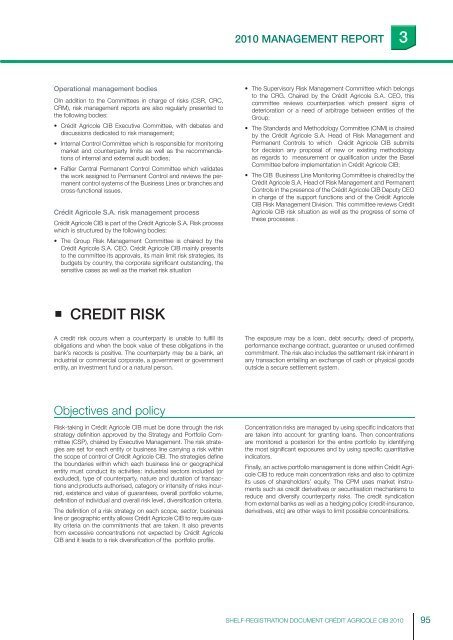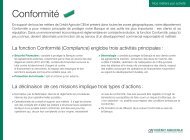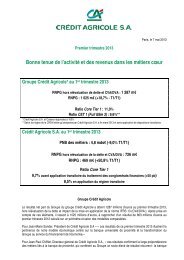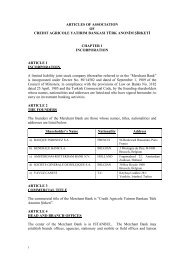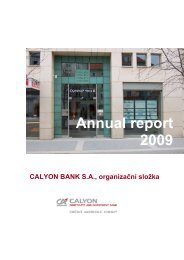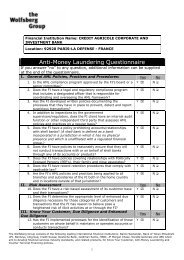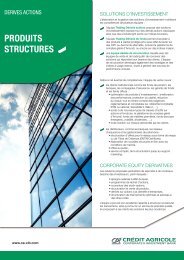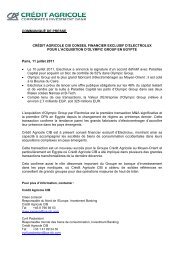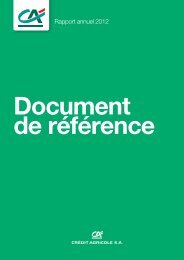ourexpertise - Crédit Agricole CIB
ourexpertise - Crédit Agricole CIB
ourexpertise - Crédit Agricole CIB
You also want an ePaper? Increase the reach of your titles
YUMPU automatically turns print PDFs into web optimized ePapers that Google loves.
2010 MANAGEMENT REPORT 3Operational management bodiesOIn addition to the Committees in charge of risks (CSR, CRC,CRM), risk management reports are also regularly presented tothe following bodies:• <strong>Crédit</strong> <strong>Agricole</strong> <strong>CIB</strong> Executive Committee, with debates anddiscussions dedicated to risk management;• Internal Control Committee which is responsible for monitoringmarket and counterparty limits as well as the recommendationsof internal and external audit bodies;• Faîtier Central Permanent Control Committee which validatesthe work assigned to Permanent Control and reviews the permanentcontrol systems of the Business Lines or branches andcross-functional issues.<strong>Crédit</strong> <strong>Agricole</strong> S.A. risk management process<strong>Crédit</strong> <strong>Agricole</strong> <strong>CIB</strong> is part of the <strong>Crédit</strong> <strong>Agricole</strong> S.A. Risk processwhich is structured by the following bodies:• The Group Risk Management Committee is chaired by the<strong>Crédit</strong> <strong>Agricole</strong> S.A. CEO. <strong>Crédit</strong> <strong>Agricole</strong> <strong>CIB</strong> mainly presentsto the committee its approvals, its main limit risk strategies, itsbudgets by country, the corporate signifi cant outstanding, thesensitive cases as well as the market risk situation• The Supervisory Risk Management Committee which belongsto the CRG. Chaired by the <strong>Crédit</strong> <strong>Agricole</strong> S.A. CEO, thiscommittee reviews counterparties which present signs ofdeterioration or a need of arbitrage between entities of theGroup;• The Standards and Methodology Committee (CNM) is chairedby the <strong>Crédit</strong> <strong>Agricole</strong> S.A. Head of Risk Management andPermanent Controls to which <strong>Crédit</strong> <strong>Agricole</strong> <strong>CIB</strong> submitsfor decision any proposal of new or existing methodologyas regards to measurement or qualifi cation under the BaselCommittee before implementation in <strong>Crédit</strong> <strong>Agricole</strong> <strong>CIB</strong>;• The <strong>CIB</strong> Business Line Monitoring Committee is chaired by the<strong>Crédit</strong> <strong>Agricole</strong> S.A. Head of Risk Management and PermanentControls in the presence of the <strong>Crédit</strong> <strong>Agricole</strong> <strong>CIB</strong> Deputy CEOin charge of the support functions and of the <strong>Crédit</strong> <strong>Agricole</strong><strong>CIB</strong> Risk Management Division. This committee reviews <strong>Crédit</strong><strong>Agricole</strong> <strong>CIB</strong> risk situation as well as the progress of some ofthese processes .• CREDIT RISKA credit risk occurs when a counterparty is unable to fulfi ll itsobligations and when the book value of these obligations in thebank’s records is positive. The counterparty may be a bank, anindustrial or commercial corporate, a government or governmententity, an investment fund or a natural person.The exposure may be a loan, debt security, deed of property,performance exchange contract, guarantee or unused confi rmedcommitment. The risk also includes the settlement risk inherent inany transaction entailing an exchange of cash or physical goodsoutside a secure settlement system.Objectives and policyRisk-taking in <strong>Crédit</strong> <strong>Agricole</strong> <strong>CIB</strong> must be done through the riskstrategy defi nition approved by the Strategy and Portfolio Committee(CSP), chaired by Executive Management. The risk strategiesare set for each entity or business line carrying a risk withinthe scope of control of <strong>Crédit</strong> <strong>Agricole</strong> <strong>CIB</strong>. The strategies defi nethe boundaries within which each business line or geographicalentity must conduct its activities: industrial sectors included (orexcluded), type of counterparty, nature and duration of transactionsand products authorised, category or intensity of risks incurred,existence and value of guarantees, overall portfolio volume,defi nition of individual and overall risk level, diversifi cation criteria.The defi nition of a risk strategy on each scope, sector, businessline or geographic entity allows <strong>Crédit</strong> <strong>Agricole</strong> <strong>CIB</strong> to require qualitycriteria on the commitments that are taken. It also preventsfrom excessive concentrations not expected by <strong>Crédit</strong> <strong>Agricole</strong><strong>CIB</strong> and it leads to a risk diversifi cation of the portfolio profi le.Concentration risks are managed by using specifi c indicators thatare taken into account for granting loans. Then concentrationsare monitored a posteriori for the entire portfolio by identifyingthe most signifi cant exposures and by using specifi c quantitativeindicators.Finally, an active portfolio management is done within <strong>Crédit</strong> <strong>Agricole</strong><strong>CIB</strong> to reduce main concentration risks and also to optimizeits uses of shareholders’ equity. The CPM uses market instrumentssuch as credit derivatives or securitisation mechanisms toreduce and diversify counterparty risks. The credit syndicationfrom external banks as well as a hedging policy (credit-insurance,derivatives, etc) are other ways to limit possible concentrations.SHELF-REGISTRATION DOCUMENT CRÉDIT AGRICOLE <strong>CIB</strong> 2010 95


